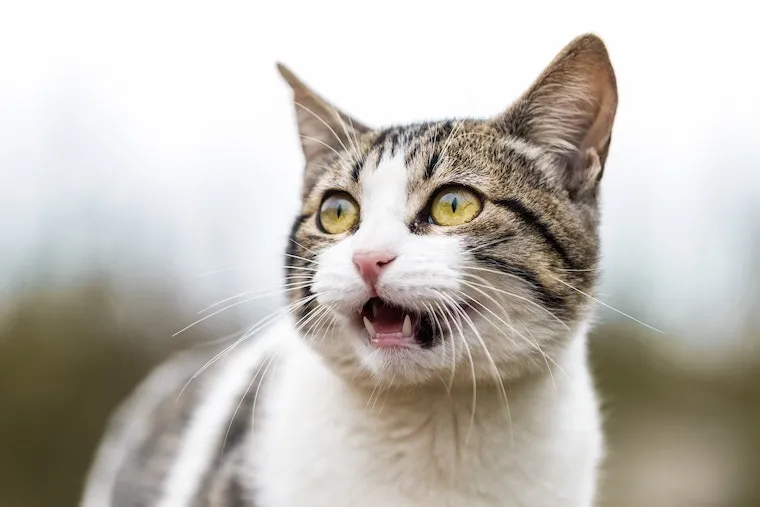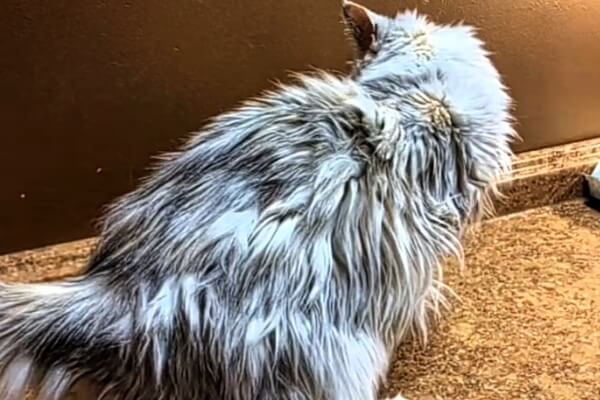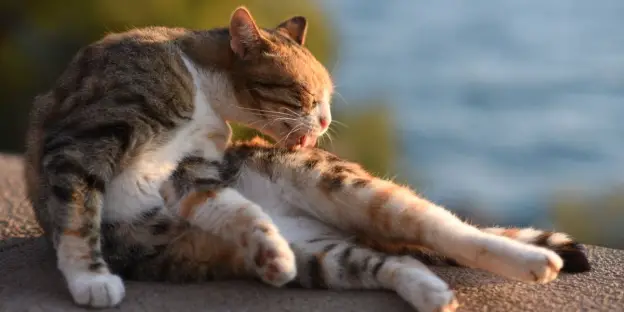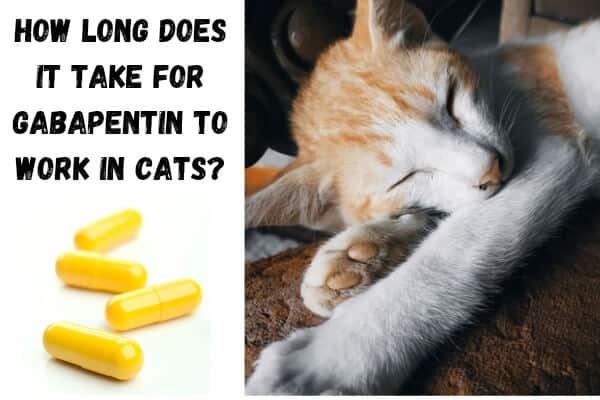Cat Litter Keeps Getting Stuck To Bum (Reasons And How To Stop It)
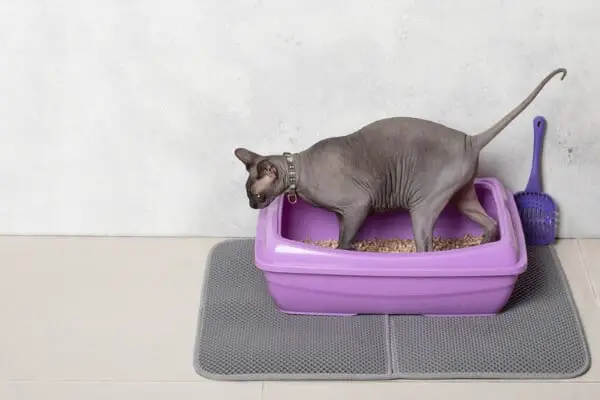
As cat parents, we all know the challenges and joys that come with caring for our feline companions. One not-so-pleasant issue that cat owners may encounter is finding bits of litter stuck to their cat’s bum. It might seem trivial at first, but it can become a source of discomfort for your cat and affect their overall hygiene.
The litter type, consistency of the fecal matter, length of your cat’s fur, and presence of health conditions like obesity, arthritis, or even lethargy play a role in limiting the natural grooming process in cats.
Cats that are overweight or suffer from joint pain may struggle to reach and clean their rears effectively, while long-furred cats provide the perfect trap for clinging bits of litter. Additionally, if your cat’s stools are too soft or loose, it’s more likely that litter will adhere to their fur. Constipation can arise from poop that is too dry, causing the poop to be stuck in your cat’s bum.
Thankfully, there are practical solutions to address this issue. The right choice of cat litter, regular and careful grooming, dietary adjustments, frequent vet check-ups, and professional grooming can all contribute to preventing litter from sticking to your cat’s bottom.
Why Does Litter Get Stuck To My Cat’s Bum?
1. Type of Litter Used
Clumping litter is designed to absorb moisture and form a hard, easily removable clump when your cat urinates or defecates. The main ingredient in most clumping litters is bentonite clay, which has excellent moisture-absorbing properties. The clumps make it easy to keep the litter box clean because you can scoop out the waste daily.
However, one potential issue with clumping litter is that if your cat has long fur or a sensitive behind, small pieces of litter can get stuck to the fur or in their anal area. These clumps, when moistened, can adhere to the fur, causing discomfort and possibly leading to poop getting stuck.
Non-clumping litter absorbs moisture but doesn’t form clumps. It is usually made from other types of clay, recycled paper, wood, or corn. Non-clumping litter is often less expensive than clumping varieties and is less likely to stick to your cat’s fur and behind but it doesn’t control odor as effectively as clumping litter, and you’ll need to replace the entire litter box contents more often to keep it clean.
The lack of clumping may mean fewer chances for litter to stick to feces and create a situation where poop is stuck to your cat’s behind, but it does not entirely eliminate the possibility.
2. Consistency of the Cat’s Stools
The consistency of your cat’s stools can significantly impact their overall health and hygiene. Soft stools can be more likely to adhere to a cat’s fur, especially around the bum area, making it difficult to clean and causing discomfort to your cat. It also increases the likelihood of litter sticking to the fur.
On the other hand, hard or dry stools can lead to constipation, a condition where the cat struggles to pass fecal matter. The dry, hardened feces can get stuck in the fur around the cat’s bum, leading to discomfort, hygiene issues, and an increased chance of litter sticking to the area.
What Causes Constipation in Cats?
Constipation in cats, or the difficulty in passing stools, can be caused by various factors ranging from dietary issues to underlying medical conditions. Understanding the causes can help cat owners take appropriate steps to prevent or treat the issue. Here are some in-depth details about what might lead to constipation in cats:
- Dehydration: Proper hydration is crucial for the functioning of a cat’s digestive system. When a cat is dehydrated, their body will attempt to conserve water by removing it from the waste in the colon, resulting in harder, drier stools that are difficult to pass. This could be due to inadequate water intake, or conditions like kidney disease or diabetes that increase urination.
- Inadequate Dietary Fiber: While cats, as obligate carnivores, don’t require as much dietary fiber as humans do, some fiber can help with the formation of bulkier, softer stools that are easier to pass. A diet lacking in fiber could lead to constipation.
- Obesity: Overweight cats are more prone to constipation. Excess body fat can put pressure on the abdomen, impacting the normal function of the digestive system. Obesity can also lead to a sedentary lifestyle, which further exacerbates the problem.
- Lack of Exercise: Regular physical activity helps stimulate the muscles in the intestines and promote regular bowel movements. Sedentary cats, especially indoor ones, might not get enough exercise to facilitate this.
- Aging: Older cats are generally more prone to constipation. This is due to a combination of factors like reduced physical activity, changes in metabolism, and the increased likelihood of concurrent diseases that can affect bowel function.
- Hairballs: Cats groom themselves regularly by licking their fur, which often leads to the ingestion of hair. While most of this hair will pass through the digestive system without issues, sometimes it can accumulate in the stomach or intestines, causing a blockage or constipation.
- Medical Conditions: Certain underlying health conditions can lead to constipation. These include neurological disorders that affect the colon’s functioning, orthopedic issues that make it painful for the cat to assume the correct position to defecate, and certain diseases like kidney disease, hyperthyroidism, or diabetes.
- Medications: Some medications can lead to constipation as a side effect, including certain types of painkillers and diuretics.
How To Help A Cat With Constipation
Constipation can cause significant discomfort for your cat, and while mild instances can be relatively common, it’s essential to address persistent issues promptly to ensure your pet’s well-being. Here are some informative and helpful steps to aid a constipated cat:
- Ensure Proper Hydration: Hydration plays a critical role in maintaining regular bowel movements. Make sure your cat always has access to clean water. Consider investing in a cat water fountain if your cat prefers moving water. Hydration can also be increased by incorporating wet food into your cat’s diet, as it contains more moisture compared to dry kibble.
- Increase Dietary Fiber: While cats require less dietary fiber than humans, adding a little to their diet can help soften their stool, making it easier to pass. Some vets recommend adding a small amount of canned pumpkin to your cat’s food as it is a good source of fiber and most cats enjoy the taste. However, always consult your vet before making significant dietary changes.
- Regular Exercise: Regular physical activity helps stimulate bowel movements. Play with your cat frequently using toys, or consider getting a cat tree to encourage climbing. If your cat is older or less active, even gentle movement can help, but always ensure the level of activity is appropriate for your cat’s age and health condition.
- Maintain a Healthy Weight: Obesity can increase the risk of constipation in cats. If your cat is overweight, discuss a weight-loss plan with your vet, including diet changes and increased exercise.
- Litter Box Hygiene: Some cats may avoid using a dirty litter box, holding in their stools, which can lead to constipation. Make sure the litter box is cleaned regularly, placed in a quiet, easily accessible location, and is large enough for your cat.
- Regular Grooming: Regularly grooming your cat, especially if they have long hair, can help reduce the amount of hair they ingest while self-cleaning, minimizing the risk of hairballs causing constipation.
- Veterinary Care: If your cat’s constipation is persistent or accompanied by other concerning symptoms like loss of appetite, vomiting, lethargy, or if they seem to be in pain, it’s critical to seek veterinary care promptly. Your vet may prescribe a cat-safe stool softener or laxative, a pro-motility drug, or, in severe cases, may recommend an enema or manual extraction of the stool. Never attempt these treatments at home without explicit guidance from your vet.
3. Fur Matting In Long-Haired Cats
Long-haired breeds such as Persians, Maine Coons, or Norwegian Forest Cats have luxurious coats that require regular maintenance.
The long hair around the hindquarters can easily get matted with feces. This can be uncomfortable for the cat, cause odors, and increase the risk of skin infections. These cats may find it difficult to keep their rear end clean due to the sheer volume and length of fur. If not groomed regularly, the fur can become a breeding ground for parasites like fleas and can also lead to the formation of painful mats.
Regular grooming is essential for long-haired cats. This includes combing the fur to prevent matting and regular ‘sanitary trims’ around the hindquarters by a professional groomer. Ensuring the cat’s diet promotes firm stools can also prevent fecal matter from sticking to the fur.
4. Health Conditions
When your cat is sick or ill, they may be too lethargic to carry on with grooming and leave their anus soiled with feces after going potty.
Overweight or obese cats often can’t reach certain areas of their bodies, including their hindquarters. This can result in feces remaining stuck to the fur after defecation.
Also, cats with health conditions like arthritis may find it painful to twist and turn to groom their rear ends. Similarly, senior cats may also have difficulty due to decreased flexibility with age.
For overweight cats, a diet and exercise plan advised by a vet can help them reach a healthier weight and improve their flexibility for grooming. For cats with health conditions, pain management, and suitable medications can make them more comfortable during self-grooming. Assisting in grooming by using pet-friendly wipes, can also be beneficial for these cats. Regular vet check-ups are crucial to monitor and manage these conditions.
How to Stop Cat Litter from Sticking to Your Cat’s Bum
Choosing the Right Litter
Selecting the appropriate type of litter can play a significant role in preventing litter from sticking to your cat’s bum. Non-clumping litter is less likely to stick to your cat’s fur, making it a suitable choice for long-haired breeds. However, if you prefer clumping litter for its easy cleanup and odor control, consider one with larger granules, which are less likely to stick to the fur. Trying out different litter types and observing your cat’s response can help you make the best choice.
Regular Grooming and the Right Tools
Regular grooming is crucial in maintaining your cat’s hygiene and preventing fecal matter and litter from sticking. For long-haired cats, keeping the fur around the bum trimmed can reduce the chances of anything adhering to it. Use a pet-friendly comb or brush to gently remove any debris from the fur. In the case of matted fur, professional groomers can help as attempting to detangle mats at home can be painful for your cat. Pet-friendly wipes or a damp cloth can be used for gentle cleaning of the bum area after using the litter box if needed.
Diet and Health Considerations
A balanced diet is essential in maintaining your cat’s overall health and the consistency of their feces. Cats on a healthy diet typically have firm, well-formed stools, which are less likely to stick to their fur. If your cat frequently has loose or diarrhea-like stools, consult a vet as it could indicate a health issue. Also, ensuring your cat stays at a healthy weight can facilitate their self-grooming habits, reducing the likelihood of feces and litter sticking to the fur.
The Role of Regular Vet Check-Ups
Regular vet check-ups are important for early detection and management of any health issues that could affect your cat’s grooming habits. Conditions such as arthritis or obesity can limit your cat’s ability to groom, making them more susceptible to issues like litter sticking to their bum. By keeping on top of their health, you can ensure your cat remains comfortable and capable of self-grooming.
Tips for Cleaning Cat’s Bum and Removing Stuck Litter
Cats are sensitive creatures, and areas like the bum are particularly so. Always approach your cat calmly and speak softly to them during the cleaning process to soothe their nerves. If your cat shows signs of stress or agitation, give them a break and try again later. It’s essential not to rush or force the cleaning process, as it can lead to fear and mistrust.
- Use Pet Wipes: Opt for unscented, hypoallergenic pet wipes to clean your cat’s bum. These are specially designed to be safe for your pet and can effectively remove stuck litter or feces. Avoid using human wipes as they may contain chemicals or fragrances that can irritate your cat’s skin.
- Warm Water And Cloth: If you don’t have pet wipes, a soft cloth or sponge with warm water can be a good alternative. Be sure to gently pat the area, don’t rub as it could lead to irritation. In case a more thorough clean is necessary, use a shampoo specifically designed for cats. Human shampoos or soap can disturb the pH balance of your cat’s skin and cause irritation.
- Consider A Rinse: In case of more stubborn debris, you may need to hold your cat’s rear under a faucet of lukewarm water. Most cats aren’t fond of water, so it’s crucial to be patient, gentle, and quick during this process.
- Hire A Professional: Moreover, be careful not to tug at any stuck litter or mats, as it can cause pain and potentially damage your cat’s skin. If it’s a dry, matted poop that you cannot remove gently, it’s best to consult a professional groomer to trim it with electric clippers.
Read our full guide teaching how to clean kitten after poop.
Final Thoughts
While it’s relatively common for cat litter to get stuck to a cat’s bum, especially in long-haired or overweight cats, it’s crucial to address this issue promptly to maintain your cat’s comfort and hygiene. Understanding the potential reasons behind this problem, whether it’s the type of litter used, the consistency of the cat’s stools, or physical limitations that inhibit grooming, can help you identify the most effective solutions.
In many cases, solutions can be as straightforward as switching to a different type of litter, regular grooming especially around the bum area, or introducing dietary changes to ensure firmer stools. Regular vet check-ups are also key in early detection and management of any health issues that could be contributing to this problem.
However, remember that every cat is unique and what works for one might not work for another. If you’re struggling with this issue, don’t hesitate to reach out to a vet or a professional groomer for personalized advice. With the right knowledge and approach, you can help your feline friend stay clean, comfortable, and happy
Read related posts about

